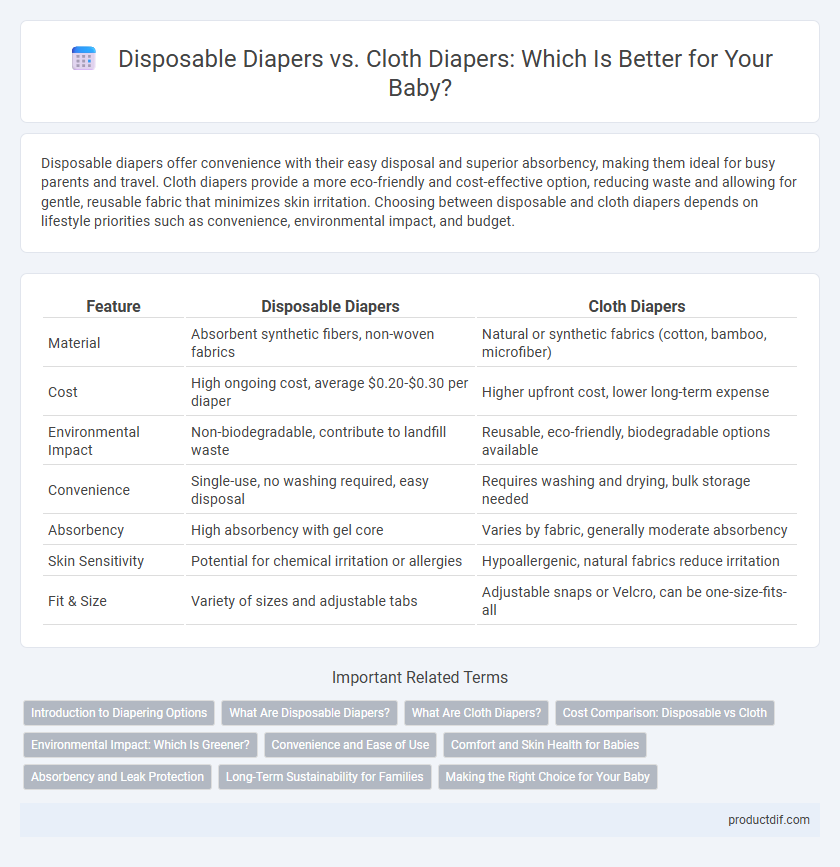Disposable diapers offer convenience with their easy disposal and superior absorbency, making them ideal for busy parents and travel. Cloth diapers provide a more eco-friendly and cost-effective option, reducing waste and allowing for gentle, reusable fabric that minimizes skin irritation. Choosing between disposable and cloth diapers depends on lifestyle priorities such as convenience, environmental impact, and budget.
Table of Comparison
| Feature | Disposable Diapers | Cloth Diapers |
|---|---|---|
| Material | Absorbent synthetic fibers, non-woven fabrics | Natural or synthetic fabrics (cotton, bamboo, microfiber) |
| Cost | High ongoing cost, average $0.20-$0.30 per diaper | Higher upfront cost, lower long-term expense |
| Environmental Impact | Non-biodegradable, contribute to landfill waste | Reusable, eco-friendly, biodegradable options available |
| Convenience | Single-use, no washing required, easy disposal | Requires washing and drying, bulk storage needed |
| Absorbency | High absorbency with gel core | Varies by fabric, generally moderate absorbency |
| Skin Sensitivity | Potential for chemical irritation or allergies | Hypoallergenic, natural fabrics reduce irritation |
| Fit & Size | Variety of sizes and adjustable tabs | Adjustable snaps or Velcro, can be one-size-fits-all |
Introduction to Diapering Options
Disposable diapers offer convenience with highly absorbent materials and easy disposal, making them popular for on-the-go parents. Cloth diapers provide an eco-friendly, reusable alternative crafted from natural fibers, which can reduce waste and long-term costs. Both options require careful consideration of comfort, skin sensitivity, and environmental impact to select the best diapering solution for a baby's needs.
What Are Disposable Diapers?
Disposable diapers are single-use baby care products designed for quick and convenient waste absorption, featuring superabsorbent polymers and waterproof outer layers. These diapers offer high absorbency and moisture-locking capabilities to keep babies dry and comfortable for extended periods. Their design focuses on convenience, hygiene, and ease of disposal, making them a popular choice among modern parents.
What Are Cloth Diapers?
Cloth diapers are reusable baby diapers made from natural fibers, synthetic materials, or a blend, designed to be washed and worn multiple times. They consist of various styles such as prefolds, fitted, pockets, and all-in-ones, offering adjustable absorbency and breathability. Cloth diapers reduce environmental waste compared to disposable diapers and provide a chemical-free option for sensitive baby skin.
Cost Comparison: Disposable vs Cloth
Disposable diapers typically cost between $0.20 and $0.40 per diaper, resulting in an average monthly expense of $70 to $80 for a baby using about 250 diapers. Cloth diapers require an upfront investment of $300 to $500 for a sufficient stash, with laundering costs averaging $15 to $20 per month, making them more economical over time. Families balancing initial expenses and ongoing savings often choose cloth diapers to reduce long-term costs, while disposables offer convenience at a higher cumulative price.
Environmental Impact: Which Is Greener?
Disposable diapers contribute significantly to landfill waste, taking hundreds of years to decompose due to their plastic and superabsorbent polymer content. Cloth diapers, while requiring water and energy for washing, offer a reusable option that reduces solid waste and overall environmental footprint when used efficiently. Life cycle assessments indicate cloth diapers have a lower long-term environmental impact, especially when line-dried and washed in full loads on energy-efficient machines.
Convenience and Ease of Use
Disposable diapers offer unparalleled convenience with their single-use design, allowing for quick changes and easy disposal, ideal for busy parents and travel. Cloth diapers require washing and drying after each use, which involves more effort but can be cost-effective and environmentally friendly over time. The ease of use in disposable diapers often outweighs the maintenance required by cloth alternatives, making them a preferred choice for on-the-go families.
Comfort and Skin Health for Babies
Disposable diapers feature advanced absorbent materials and breathable layers designed to keep babies dry, reducing the risk of diaper rash and ensuring optimal skin comfort. Cloth diapers, made from natural fibers like cotton or bamboo, offer exceptional breathability and softness that promote healthy skin by minimizing irritation and maintaining moisture balance. Choosing between disposable and cloth diapers depends on prioritizing immediate convenience and dryness or long-term skin health and eco-friendly comfort for babies.
Absorbency and Leak Protection
Disposable diapers offer superior absorbency with multi-layer cores that quickly lock in moisture, reducing the risk of leaks during extended wear. Cloth diapers rely on natural fibers like cotton or bamboo, which absorb well but require frequent changing to prevent leaks. Advanced disposable designs often include elastic barriers and breathable materials that enhance leak protection compared to traditional cloth options.
Long-Term Sustainability for Families
Disposable diapers generate significant landfill waste and rely on non-renewable materials, impacting long-term environmental sustainability. Cloth diapers, though requiring more upfront investment and water for washing, offer reusable benefits that reduce overall waste and resource consumption over time. Families aiming for long-term sustainability often prioritize cloth diapers to minimize ecological footprint and support eco-friendly parenting practices.
Making the Right Choice for Your Baby
Choosing between disposable diapers and cloth diapers depends on factors such as convenience, environmental impact, and cost-effectiveness. Disposable diapers offer superior absorbency and ease of use, while cloth diapers are reusable, eco-friendly, and can reduce long-term expenses. Parents should consider their lifestyle, baby's skin sensitivity, and sustainability preferences to make the best decision for their baby's comfort and health.
Disposable Diapers vs Cloth Diapers Infographic

 productdif.com
productdif.com